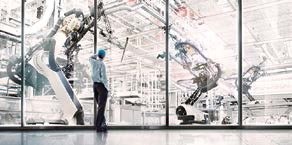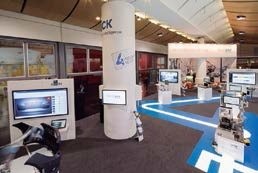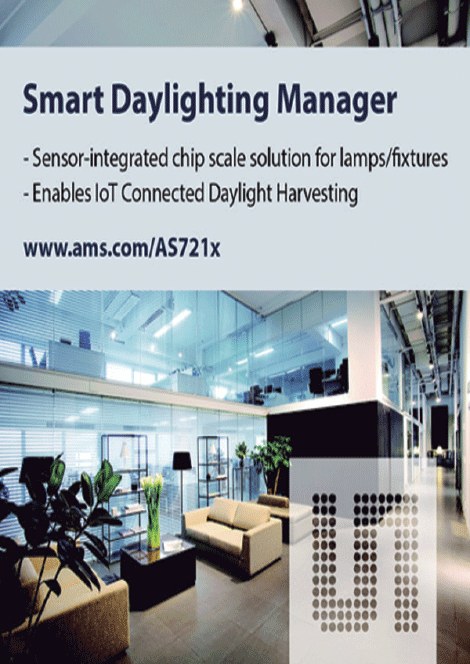The information age in the industrial sector is still in its early stages. Unlimited sharing of manufacturing, product and logistics data means that better decisions are now possible and experience complete transparency at all levels of the value chain. At the beginning of the process chain, this greater efficiency of resources depends to a large extent on the equipment that supplies this data: intelligent sensors. Intelligent, robust and reliable sensor technology is absolutely essential in addressing challenges such as safe human-machine interaction, high levels of diversity and monitoring short notice fluctuations in demand. Sensors serve as sense organs for machines, and the information they provide is the primary factor that makes intelligent machines possible. Sensor intelligence focuses on one aspect of sensor technology: providing machines with the ability to see, sense, and communicate intelligently. Smart sensors contribute to the ability to classify and interpret information. This aspect is characterized by intelligent signal processing, which separates the truly relevant information from large volumes of data and makes it available to different resources. For this reason - in addition to the primary control system of machines and systems - information is provided to monitor production systems and allow fault detection. The transparency of material and process flows creates additional potential for optimization. Thus, the processes become more efficient and profitable, in addition to increasing their competitiveness. Looking at the four challenges at the production levels—“Quality Assurance” at the sensor and drive level, “Flexible Automation” at the machine level, “Safety” at the production level, and “Track and Trace” at the corporate level—it is clear that, as technology providers for Industry 4.0, we are already capable of presenting and implementing solutions. Flexible automation requires variable basic conditions. Manufacturing plants must be flexible and adapt to the wishes of each customer. Due to the great diversity of products, even as batch sizes continue to shrink, smart components (smart sensors) must be able to adjust and control themselves. The main motivation in safety is the interaction between people and machines taking into account the safety and ergonomics of the workplace. In this regard, the essential questions relate to the role that people must play in future production and the way in which sensors can help them and offer them security in this task. Vertical integration: a key term for track and trace. Product traceability in complex manufacturing and logistics processes is a priority for this integration. The logistics for production and transport go hand in hand until delivery to the customer; therefore, the flow of materials must be transparent to make decisions more quickly. Increasing quality requirements and the desire for resource efficiency require autonomous fault detection via comprehensive product and production data.
Flexible automation: personalization of materials in the packaging process
If we take a packaging machine as an example, we can see how an automatic batch change without manual intervention, through the use of intelligent components with automated control, generates a greater diversity of products with an overall increase in productivity. Achieving maximum productivity with a product variation up to lot size 1 is one of the central objectives of the Industry 4.0 concept. Manufacturing plants must be flexible and adapt to the wishes of each customer. Due to the great diversity of products, even as batch sizes continue to shrink, smart components (smart sensors) must be able to adjust and control themselves. An example could be the final packaging of pre-packaged batches with bottle sizes of 0,5 l and 1,5 l with packing capacity in the same system through detection by intelligent sensors with an automatic change of format. The sensors detect the change of product and communicate to the control system that it must be readjusted to configure the correct box, insert the bottles and label the box for transport. Change steps are displayed on a monitor as the machine is adjusted. The system continues to work automatically and does not need to be restarted manually. If the sensors detect an incorrect placement when measuring the length of the product, they notify the control system. The product is sorted without stopping the system. In addition, the sensors provide data for proactive maintenance, for example by monitoring the system for fine particles, to automatically implement measures to safeguard the packaging process. Smart and communication-capable sensors are the core element that makes Industry 4.0 possible. Smart sensor solutions (the use of the latest sensor technologies, in combination with full integration at the control level) largely focus on decentralizing certain automation functions to direct them to the sensor. This takes some of the load off the control system and increases the productivity of the machines.
Safety: Robot protection using laser scanners
Sensor intelligence is a prerequisite for safe human-machine interaction in the Industry 4.0 era. Safe laser scanners reliably monitor the danger zone of mobile or stationary machines or systems, such as welding robots or driverless transport systems. In this area, the protection of people is the top priority. If a person enters this area, the dangerous movement must be stopped safely. In conventional systems people are protected, but production stops. In the future, Industry 4.0 smart sensors will be used not only to ensure the safety of people, but also to implement the ever-increasing production specifications. Today, SICK already provides up to four simultaneous protective fields, which considerably increases the ergonomics and efficiency of complex machines such as tire warmer presses. The currently used digitally switched protective fields are being replaced by flexible ones. Flexible protective fields are automatically calculated during highly dynamic movements and adjusted according to the danger zones of the robot. Commissioning is also considerably simplified and speeded up thanks to smart sensors. The optimal interaction between intelligent sensors and the latest machine designs increases the productivity of the machine and ensures the safety of employees at all times. The compact systems use an integrated oscillating mirror that acts as an optical radar to scan the surroundings in two dimensions and measure distances based on the principle of time-of-flight measurement. This makes it possible to have security zones that can be freely defined.
Track and trace: production and logistics chains grow together
An example from the automotive industry: Comprehensive data acquisition directly in the vehicle makes it possible to identify a specific customized vehicle throughout the entire production process right up to delivery. This track and trace example makes it clear how increasing product customization can be implemented in the context of Industry 4.0. The sensors detect, directly on the vehicle body, the assembly steps to be applied, so it is impossible to confuse or mix steps. Thanks to these sensors, complete transparency is guaranteed until delivery. Processing steps on the object are updated using rewrite-capable RFID tags. To do this, the reading must be completely reliable, since any error could cause address errors, confusion or downtime. It is in this field that RFID data cards, which can be embedded in components or even integrated into them invisibly, are increasingly being used. In practice, they offer the highest possible degree of availability. For example, they withstand high temperatures in a paint line and can be reliably identified even when covered in paint.
The basic concept of a lot size 1
Aspects such as transparency and traceability play an increasingly important role for manufacturers, as the level of diversity on the production lines of large automobile manufacturing plants is constantly growing, and assembly lines process more and more parallel variants. Vertical integration: a key term for track and trace. Product traceability in complex manufacturing and logistics processes is a priority for this integration. Production and logistics require transparent material flows in order to make production decisions faster.
Delivery
RFID-based material flow transparency also plays an essential role in delivery. Until the finished vehicles are ready for collection and transport to the dealership, they remain stored in a large parking area. The problem is how to find the vehicle to load on the truck, as each of these cars is custom built 90 to order and no two are alike. Thanks to the information stored in an RFID tag, the client's customized car is quickly located and can be loaded for transport without wasting a second. Transparency and monitoring of follow-up until delivery to the client.
Quality control: reliability in data acquisition and monitoring
In the future, the speed with which packets are transported will only increase, and the distances between them are getting smaller and smaller. Therefore, checking the quality of the products becomes even more important. To achieve this, data from the package is read from the conveyor belt and transferred to the software, which identifies and compares each of these packages. Is there damage to the package? Is the code complete? Are the weight and volume the same? Are the packages stacking up or are some missing? Automatic error detection is possible thanks to comprehensive product and production data. Data is fully synced in a matter of seconds. Defects can be tracked in all centers and it is possible to detect the location of weak points. Furthermore, quality defects can be identified and fixed during the process. As the speed of the conveyor belts is further increased, maximum productivity is guaranteed, not only at each location, but also globally. This example of an intralogistics process shows how increasing quality requirements and the desire for greater resource efficiency can be implemented in the context of Industry 4.0. Sensors detect changes in the object and enable seamless data acquisition. The software analyzes the process data and implements measures. The combination of a variety of data and analysis software is an important prerequisite for Industry 4.0 and the sustainability problem. Materials in the production process and supply chain must be reliably and unambiguously identified to enable efficient automated control. From a single package on a conveyor belt to a complete overview of millions of packages transported daily, there must be a convenient method of querying and analyzing the status of all acquired data. Smart sensors are responsible for acquiring and transmitting this data. However, users do not perceive the real added value until this data can be used to improve business processes. This data offers great opportunities, but also implies the significant challenge of preparing it in a way that allows companies to make the right decisions. This is the cornerstone of Industry 4.0: the seamless flow of data and information from the sensor to the control system and vice versa.
From conventional sensors to smart sensors
SICK has always developed and manufactured intelligent sensors. The fact that the company has been at the forefront of the industry for ten years by focusing its efforts on sensor intelligence underscores the continued development of its corporate strategy, literally epitomized by its tagline, “Sensor intelligence”. As a result, SICK already envisioned the future of automation in 2004; a vision that is currently identified with terms such as “Industry 4.0”. The continuous development of smart sensors does not mean that the future and the past are independent, but rather that they form an indissoluble unit of technological developments that depend on each other. The founder of the company, Dr. Erwin Sick, conceived this vision of sensors with optical and mechanical precision. Starting in the 1950s, he used his vision to create pioneering smart solutions, for example to protect machines and monitor emissions. Soon after, advances in electronics allowed devices to be miniaturized and became the driving force for automation engineering. The success of microelectronics persists even today. An eloquent example of this can be seen in the ASICs (application-specific integrated circuits) that SICK developed and uses in devices such as optical and inductive sensors. The increasing speed of computing power of modern chips makes possible the remote processing of significantly larger volumes of data and capabilities such as the associated use of complex mathematical methods. This opens up entirely new dimensions in terms of measurement range, precision and robustness. Sensor solutions capable of measuring in various dimensions, such as camera systems and laser scanners, would also not be possible without this development, due to their large volume of data. Computing power allows for even smarter sensors, but this intelligence is useless until combined with the right software and application knowledge. The intelligent combination of application knowledge and the flexibility of modern software architectures enables the next stage in sensor development to be reached. This stage is characterized by the existence of sensors capable of carrying out more exhaustive analysis, automatically adapting to changes, communicating in a network and remotely solving complex tasks in a larger manufacturing network. In other words, the sensor connects to the machine, the system, the factory and the entire value creation chain, providing transparency in production. As a result, it becomes the access point to the world of Industry 4.0. However, in all virtual worlds, the intelligence of the sensors is still a part of the whole: the sensor. Even cloud services and software applications need to be supported on a physical foundation of the industrial environment, that is, on a robust and reliable hardware component.





